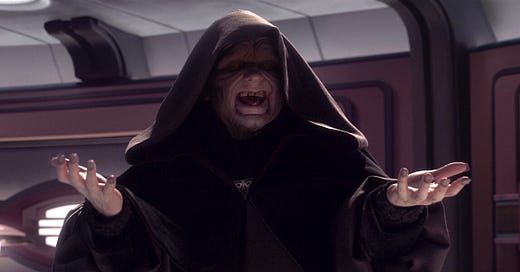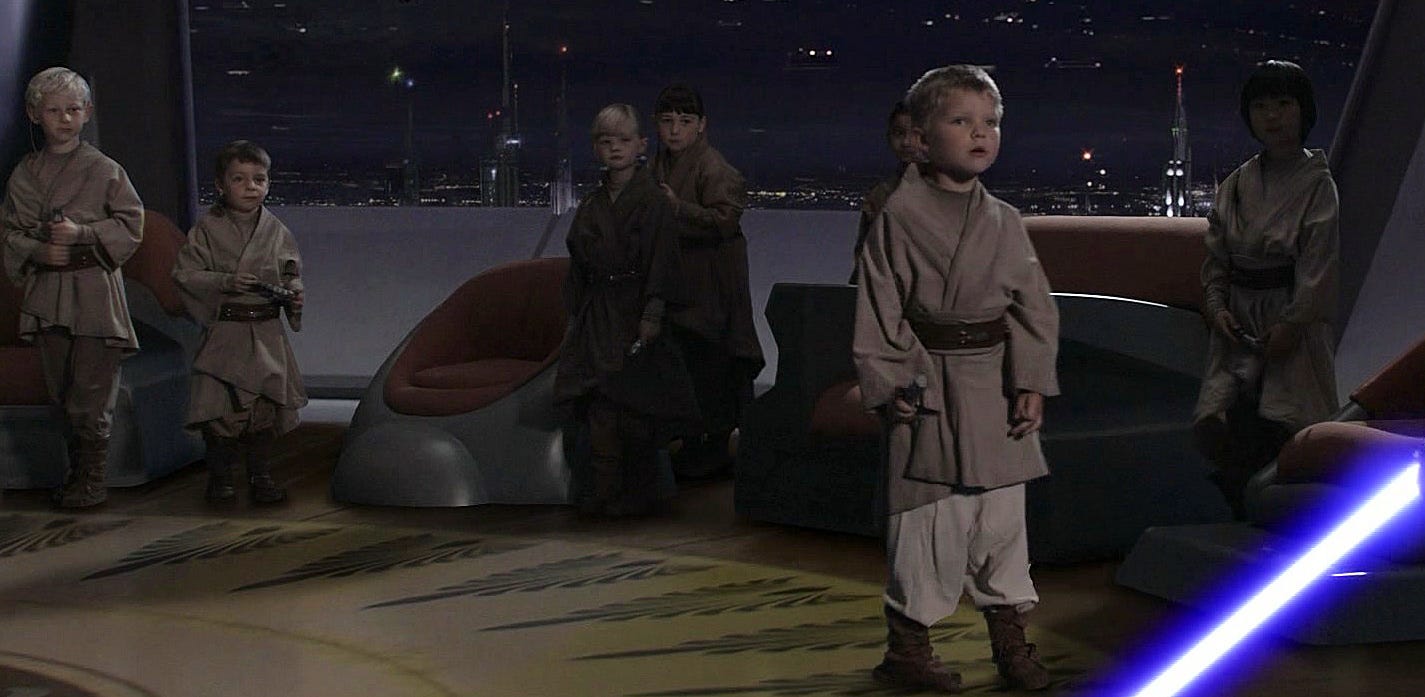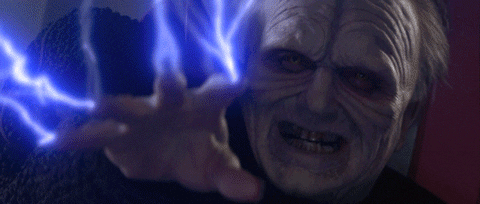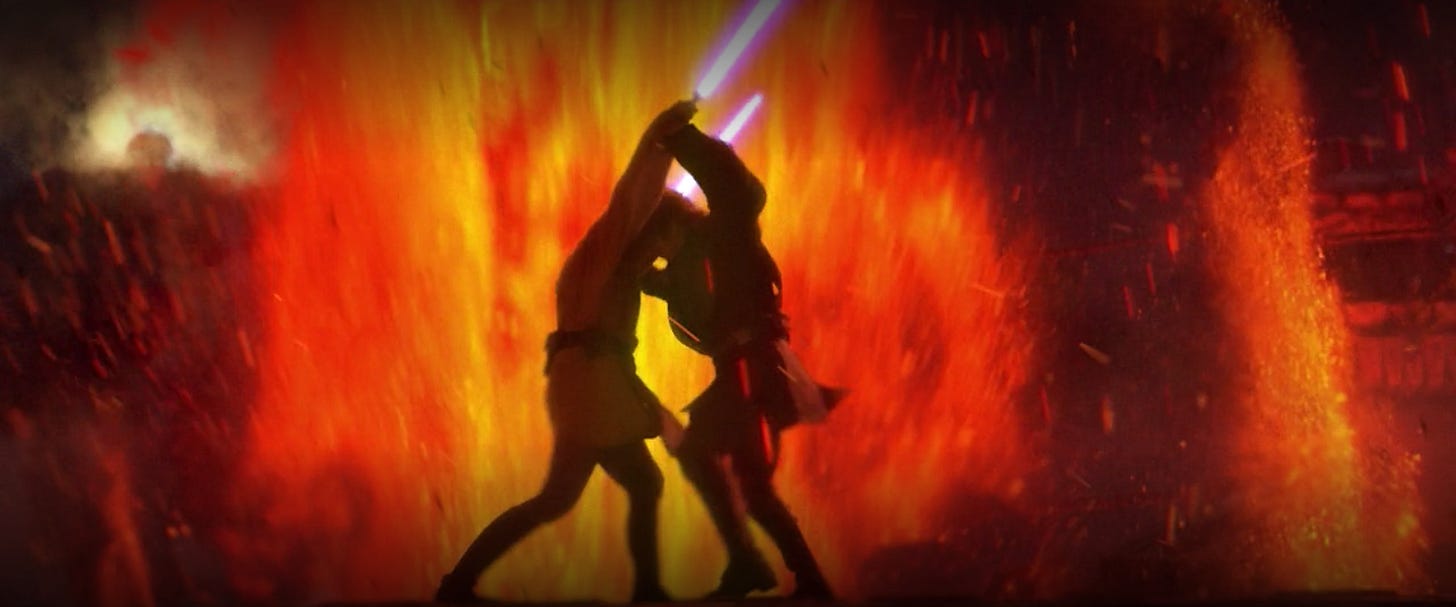Anakin Skywalker isn’t specifically told to murder children.
When he and a unit of clone soldiers march on the Jedi Temple to root out so-called “enemies of the Republic,” after a failed attempt to kill his new Sith master, the evil Chancellor Palpatine (Ian McDiarmid), he’s told to “kill all the Jedi in the temple.” These younglings, while aspiring to be Jedi, haven’t earned the title and aren’t in any way a threat.
His orders are left open to interpretation because unlike the Jedi, who adhere to a strict ethical code, the Sith are unbound. They choose how far to go, and how extreme to fulfill their master’s bidding.
After ambushing and mowing down legions of his former comrades, Anakin (Hayden Christensen) enters a room where several younglings hide. One of them, who bears a resemblance to young Apprentice Anakin at the very end of Episode I,1 asks him, “Master Skywalker, what do we do?” Anakin clicks on his lightsaber, its menacing hum causing the youngling to step back in shock.
This is not the first time Anakin has murdered younglings in cold blood, though.
In Episode II,2 he takes outsize retribution on the Tuskin Raiders who captured, beat, and killed his mother. He kills not only the male warriors responsible but civilian women and children, too.
“They’re animals, and I slaughtered them like animals!” he yells.
George Lucas draws verbal and visual parallels between Anakin and Ethan Edwards, John Wayne’s defiantly racist cowboy in the John Ford masterpiece The Searchers. Anakin learns codes and ways of life so that he can violate them. It is not enough to get even, he wants to eradicate those who wrong him’s very existence. That means putting a stop to future warriors while they’re too young to fight back.
To state the obvious, Revenge of the Sith is an incredibly bleak film. The carefully laid plans that Palpatine has been building on both sides of the central conflict in the previous two films are executed at a breathtakingly sudden pace here. He knows that acting fast to root out and suppress all opposition is the easiest way to secure….
Lucas creates images of grandly sinister inevitability in showing Palpatine and Anakin’s rise- hordes of white-armored troops marching in lockstep, a newly-crowned dictator raising his arms to the thunderous applause of his subjects. Nothing matches the sense of deep tragedy as the montage that follows Palpatine’s command for his army to “execute Order 66,” though.
Until now, the Jedi were given the pretense of active participation in this new clone army. They led troops into war against their enemies, the endless robot battalions of the Separatists. But with three simple words, Palpatine reveals his hand: The clones can instantly be made to turn on anyone he deems a threat. Familiar faces from the Jedi Council are ambushed by the very troops they’re leading, gunned down in the midst of battle.
We’ve seen this coming. Throughout The Prequels, Lucas does not attempt to hide that Palpatine is both a leader of the Republic and pulling the strings of the Separatist movement. Part of what gives this trilogy, and Revenge of the Sith in particular, its lasting bite is this sense of helplessness. Palpatine is always at least one step ahead of everyone, and so are we.
The Jedi are culpable in his takeover because of their willingness to compromise and hesitancy to act in the face of encroaching authoritarianism. They hem and haw, clutch their chests in pain when they feel a disturbance in The Force, but ultimately they are inadequate to meet the needs of the moment.
In Episode II, the Jedi Master Mace Windu (Samuel L. Jackson) says, “We’re keepers of the peace, not soldiers.”
What does keeping the peace look like if not stopping a would-be tyrant from fulfilling his ambition? By the time Windu and the other Jedi are keyed into Palpatine’s plan, they are too spread out in various conflicts on other planets to match him. It’s too late.
Revenge of the Sith climaxes with two high-concept lightsaber duels. One features Palpatine and the Jedi leader Yoda jumping around the Senate chamber, the former hurling representative’s seating pods3 and lightning bursts at his little green opponent.
After two films of restrained political calculation, Palpatine is gleefully unhinged here. McDiarmid’s emphatic vocal inflections and facial contortions give the character a sense of uninhibited, even joyous villainy.
In a way, setting Palpatine loose in this film is a Dark Side counterpart to the delightfully acrobatic Yoda duel in the previous film. These characters are old and creaky in the Original Trilogy and are now quite literally leaps and bounds ahead of their opponents.
However thrilling it is to watch AARP Lightsaber Duels for Grownups, though, the second prominent showdown at the end of this film may just be the high watermark of the entire series.
After years of passive-aggressive rule questioning and insubordination, Anakin, now going by Darth Vader, goes head-to-head with his former master, Obi-Wan Kenobi (Ewan McGregor).
Their battle on the volcanic planet Mustafar is a marvel of action choreography, thunderous music, and chaotic, shifting landscapes. Blue lightsabers clash amid a sea of erupting red and orange lava, the two warriors navigating volatile machinery in their attempts to dominate the other.
I’m probably starting to sound like Camille Paglia,4 but the finale of this film really is the synthesis of everything Lucas sought to do in The Prequels. It’s as if he has cracked open the heart of his universe and let it bleed out with an apocalyptic blend of dance combat, CGI fire and brimstone, and industrial production design. This sequence at this scale was impossible not only when the Original Trilogy was made, but also when the first movie in this trilogy was made.
The Mustafar duel shows us the extent of Anakin’s fall from grace in appropriately operatic terms: his transformation from a rebellious twink to the disfigured, robotic Darth Vader. But because Lucas can never have enough cross-cutting, he continues well beyond these two lightsaber battles. The Frankenstein-esque assembly of Darth Vader is contrasted with Padme (Natalie Portman), his wife, dying in childbirth. Her twins, Luke and Leia, are separated so it’s harder for Vader to find them.
Leia is taken to live with royalty on the prosperous, blue-green planet Alderaan, and Luke is sent to the desert planet Tattooine, his father’s old home, to grow up on a farm with his aunt and uncle.
Revenge of the Sith ends by mirroring an iconic shot from the original Star Wars: Luke’s aunt and uncle holding him, gazing out at endless sand as two suns hover over the horizon. Lucas updates the image in this film by adding digital swirls of color to the sky.
But placing this image at the end of his saga also complicates it. As Palpatine and Vader plot to cement their rule, the Jedi have gone into self-imposed exile. Their so-called Chosen One has all but destroyed them, and now they must wait for another. Maybe next time, their prophetic visions will light a little more fire under their asses.
Revenge of the Sith is streaming on Disney+.
There is a time and place for subtlety, and it is not in a lightsaber duel








